Energy Storage Science and Technology ›› 2023, Vol. 12 ›› Issue (5): 1713-1737.doi: 10.19799/j.cnki.2095-4239.2023.0081
• Energy Storage Test: Methods and Evaluation • Previous Articles Next Articles
Yifan HAO1( ), Xiayu ZHU2, Jing WANG1, Jingyi QIU2, Hai MING2(
), Xiayu ZHU2, Jing WANG1, Jingyi QIU2, Hai MING2( ), Zhenhua FANG3
), Zhenhua FANG3
Received:2023-02-17
Revised:2023-03-15
Online:2023-05-05
Published:2023-05-29
Contact:
Hai MING
E-mail:hao.yf@stumail.ysu.edu.cn;hai.mingenergy@hotmail.com
CLC Number:
Yifan HAO, Xiayu ZHU, Jing WANG, Jingyi QIU, Hai MING, Zhenhua FANG. Analysis of battery nondestructive testing and monitoring methods[J]. Energy Storage Science and Technology, 2023, 12(5): 1713-1737.
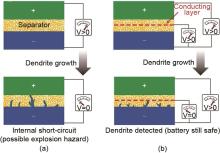
Fig. 3
Schematic of the smart battery design and fabrication. (a) Dendrite formation in a traditional lithium battery where complete penetration of the separator by a lithium dendrite is only detected when the battery fails due to an internal short circuit and VLi-Li drops to zero; (b) In comparison, a lithium battery with a bifunctional separator where the overgrown lithium dendrite penetrates into the separator and makes contact with the conducting copper layer, giving rise to a drop in VCu-Li as warning of impending failure due to an internal short circuit. As well as, the full battery remains safely operational with non-zero potential[11] (NatureCommunications has image copyright)"


Fig. 4
(a) Schematic of customized RTD embedded LIB coin cell; (b) RTD embedded polylactic acid spacer and CR2032 cell with internal RTD. Dimension of the RTD embedded spacer was comparable to ordinary CR2032 coin cell spacer, allowing for reliable sensor-electrode contact and cell sealing after assembly[22](ScientificReports has image copyright)"
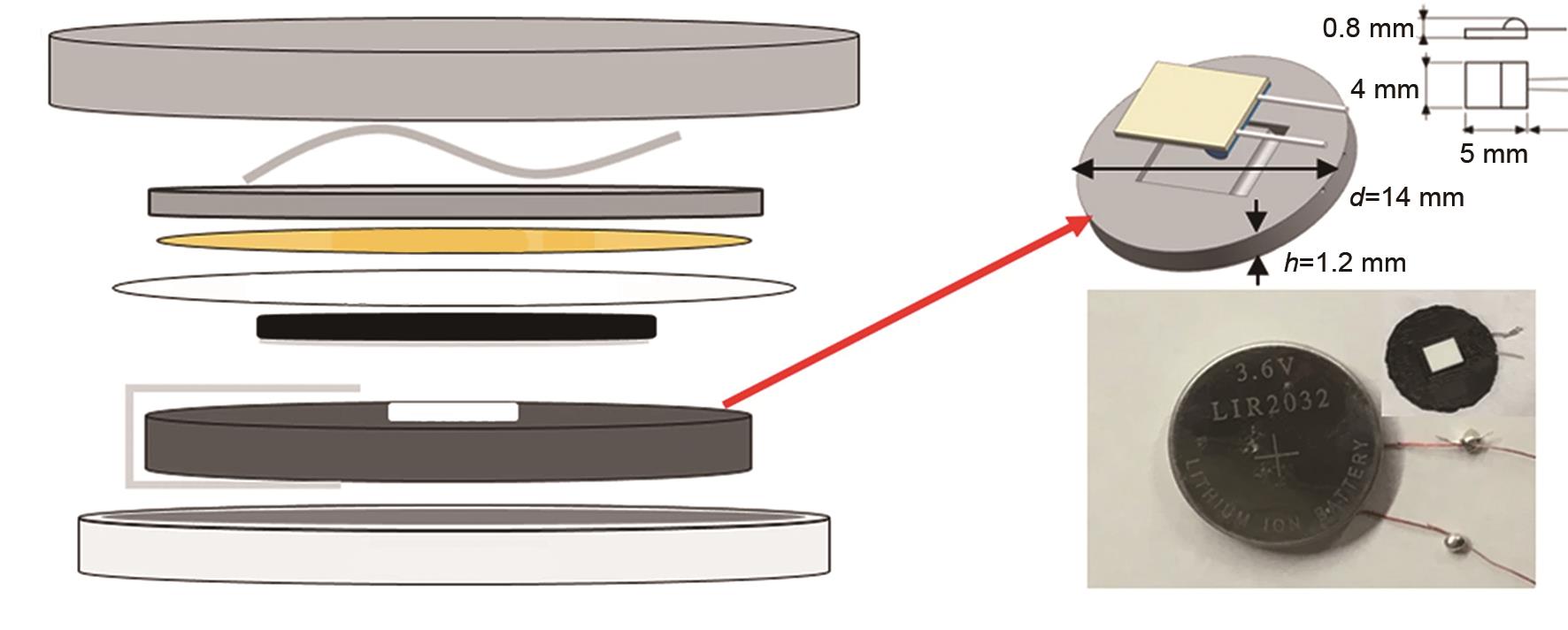

Fig. 8
Schematic of the cell embedded with FBG and corresponding electrochemical performance. (a) The schematic illustration of the structure of FBG and the Li-S pouch cell embedded with FBG; (b) The cycle performance and (c) discharge-charge curves of the Li-S pouch cell embedded with FBG and a normal cell without FBG[23] (EnergyEnvironmentalScience has image copyright)"
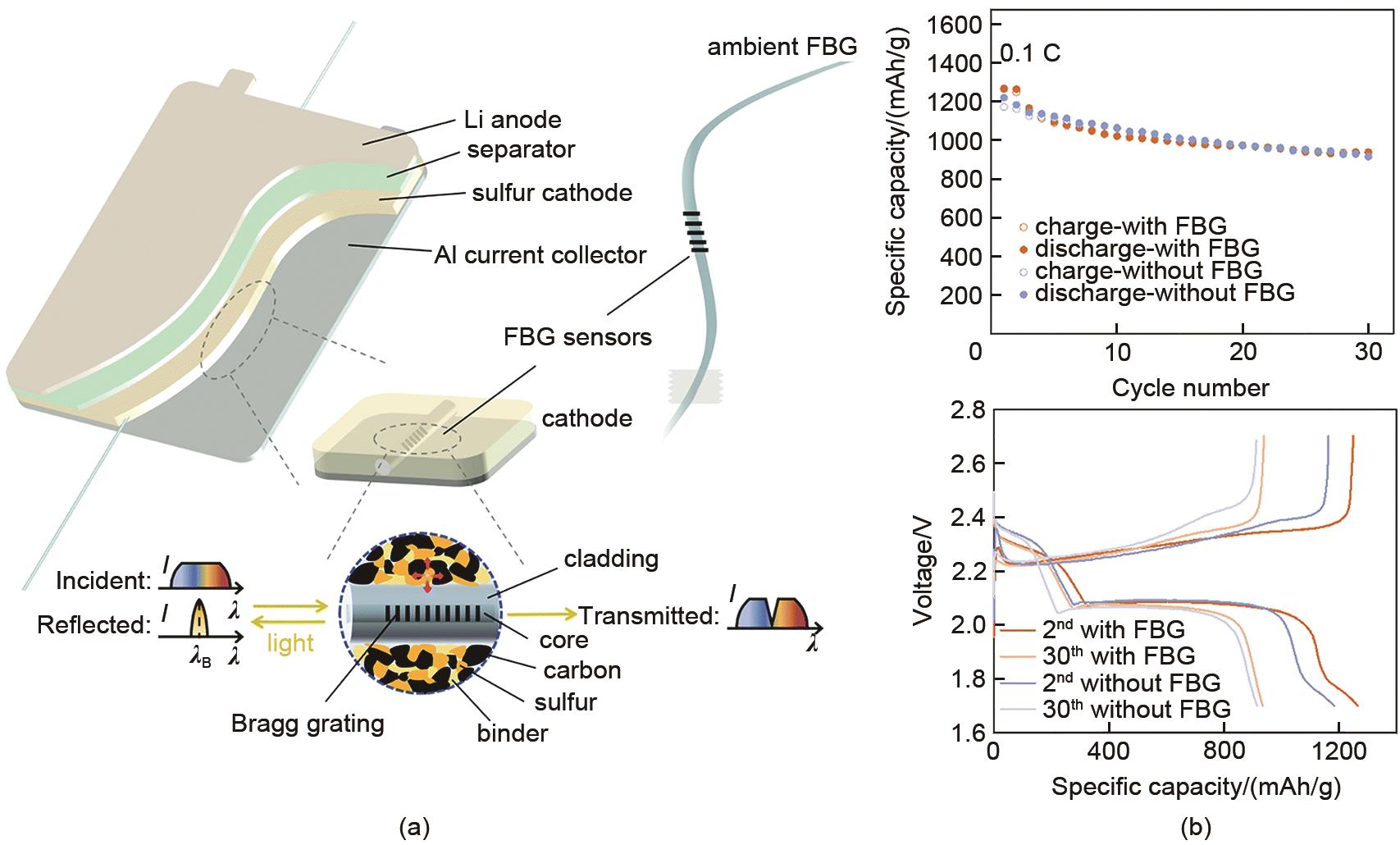
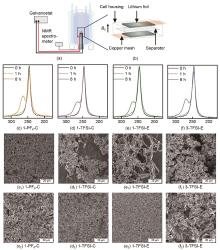
Fig. 10
(a) Schematic depiction of the measurement setup with a thin film pouch cell placed in the coil of a NMR device, connected to a battery cycler; (b) Schematic thin film pouch cell; (c)—(f) 7Li-NMR spectra of thin film pouch cells and SEM images of the corresponding electrodes after (c1—f1) and (c2—f2) 8 hours of electrodeposition at 0.5 mA/cm2 containing 1-PF6-C, 1-TFSI-C, 1-TFSI-E and 3-TFSI-E[59] (PhysChemChemPhys has image copyright)"

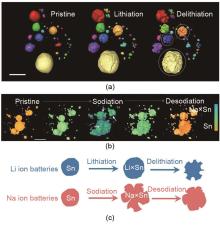
Fig. 15
(a) 3D visualization of Sn particles at the first lithiation-delithiation process; (b) 3D morphological change of Sn particles at the first sodiation-desodiation cycle; (c) Schematic illustration showing the difference of Sn microstructural change in sodium-ion battery and lithium ion battery[75](NatureCommunications has image copyright)"


Fig. 18
Image displays the reconstructed tomograms from neutron and X-ray CT along with examples of sections extracted following virtual unrolling of the reconstructions. Clearly visible in the X-ray images is the nickel current collecting mesh, which appears brighter than the Li X MnO2 active electrode material[27](Naturecommunication has image copyright )"
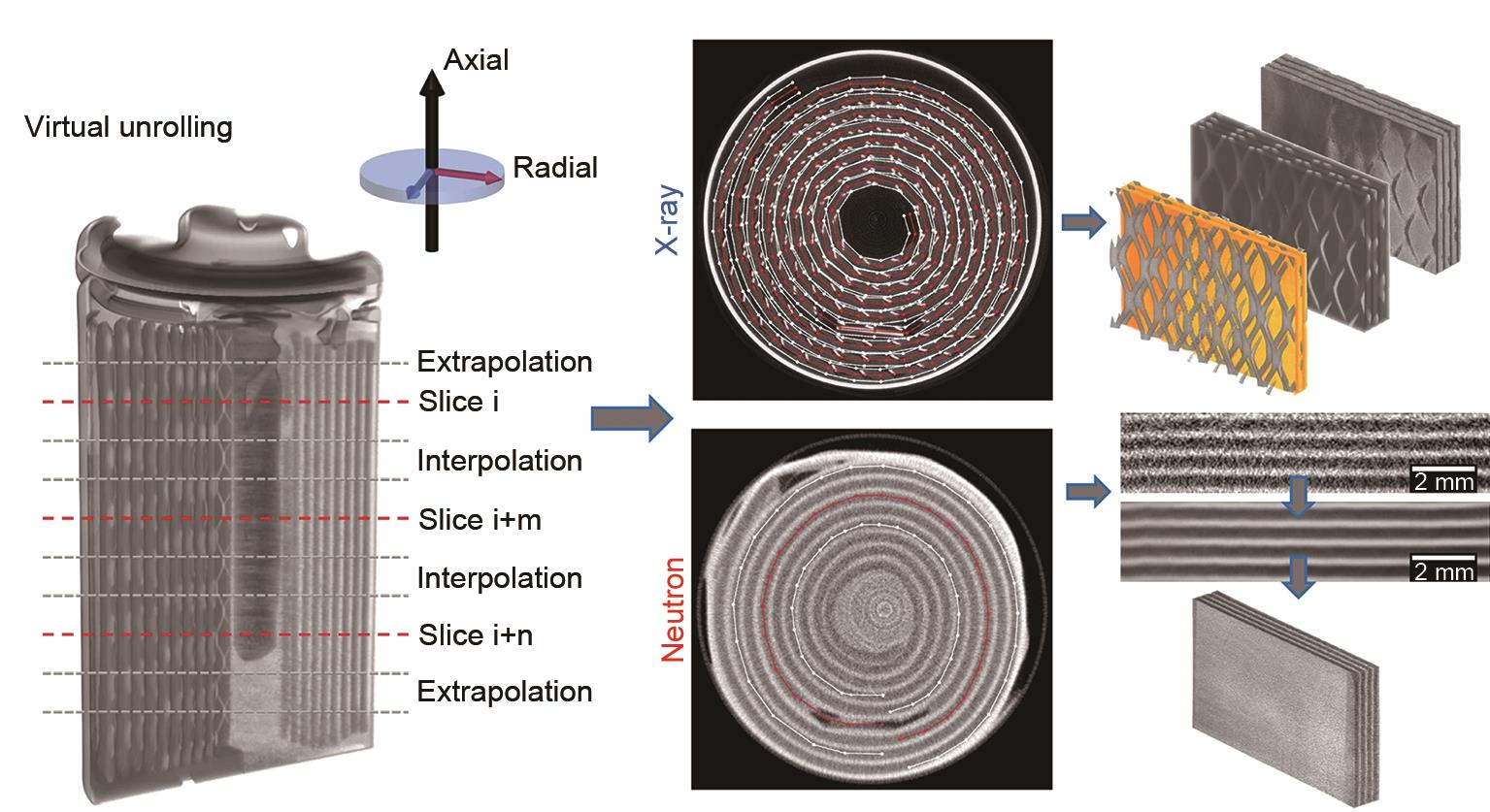
Table 1
Overview of comparison and analysis of battery non-destructive testing monitoring methods"
| 电池无损检测监测方法 | 适用研究场景及特点 | 面临的挑战 | |
|---|---|---|---|
| 传感器 技术 | 电压传感器、温度传感器、气体传感器、光纤传感器 | 传感器以嵌入方式植入单体电池内部,实时监测电压、温度、释放的气体和应变等参数 | 单体电池异常情况对于大电池组变化细微,难以有效警示;在电池内部恶劣环境下,传感器监测精度和寿命受到一定影响 |
| 磁共振 技术 | 核磁共振技术(NMR)、电子顺磁共振技术(EPR) | 可以对金属进行定性和(半)定量检测;监测电极、电解质分解及其界面上原子核周围的局部电子环境等 | 低分辨率;仅根据NMR光谱化学位移对锂沉积物微观结构性质定性分析不充分 |
| X射线 技术 | X射线吸收光谱(XAS)、X射线计算机断层扫描技术(CT) | 定性定量地分析电极组件材料元素组成、电子态以及微观结构、界面相互作用等 | 时间分辨率低;对轻元素(锂、氧、钠)不敏感 |
| 中子散射技术 | 穿透力强,可从原子尺度研究材料物质结构和动态特性;对锂、钠、氧等轻元素敏感 | 散射低通量、亮度低 | |
| 其他 技术 | 超声波检测技术 | 通过声波变化较为灵敏地持续无损监测电极材料的机械性能和结构变化 | 超声检测设备较大,难以与电池组组装 |
| 拉曼散射技术 | 定性定量检测电极材料结构变化以及样品浓度 | 时间分辨率差;难以在液体电解质中成像离子传输过程 | |
| 1 | SUN H T, MEI L, LIANG J F, et al. Three-dimensional holey-graphene/niobia composite architectures for ultrahigh-rate energy storage[J]. Science, 2017, 356(6338): 599-604. |
| 2 | ASSAT G, TARASCON J M. Fundamental understanding and practical challenges of anionic redox activity in Li-ion batteries[J]. Nature Energy, 2018, 3(5): 373-386. |
| 3 | PAREKH M H, LI B, PALANISAMY M, et al. In situ thermal runaway detection in lithium-ion batteries with an integrated internal sensor[J]. ACS Applied Energy Materials, 2020, 3(8): 7997-8008. |
| 4 | TANG F C, WU Z B, YANG C, et al. Synchrotron X-ray tomography for rechargeable battery research: fundamentals, setups and applications[J]. Small Methods, 2021, 5(9): e2100557. |
| 5 | 邓林旺, 冯天宇, 舒时伟, 等. 锂离子电池无损析锂检测研究进展[J]. 储能科学与技术, 2023, 12(1): 263-277. |
| DENG L W, FENG T Y, SHU S W, et al. Nondestructive lithium plating online detection for lithium-ion batteries: A review [J]. Energy Storage Science and Technology, 2023, 12(1): 263-277. | |
| 6 | LIU Q N, TANG Y F, SUN H M, et al. In situ electrochemical study of Na-O2/CO2 batteries in an environmental transmission electron microscope[J]. ACS Nano, 2020, 14(10): 13232-13245. |
| 7 | HAN S B, CAI C, YANG F, et al. Interrogation of the reaction mechanism in a Na-O2 battery using in situ transmission electron microscopy[J]. ACS Nano, 2020, 14(3): 3669-3677. |
| 8 | RONG G L, ZHANG X Y, ZHAO W, et al. Liquid-phase electrochemical scanning electron microscopy for in situ investigation of lithium dendrite growth and dissolution[J]. Advanced Materials, 2017, 29(13): 1606187. |
| 9 | GOLOZAR M, PAOLELLA A, DEMERS H, et al. In situ observation of solid electrolyte interphase evolution in a lithium metal battery[J]. Communications Chemistry, 2019, 2(1). |
| 10 | ZACHMAN M J, TU Z Y, CHOUDHURY S, et al. Cryo-STEM mapping of solid-liquid interfaces and dendrites in lithium-metal batteries[J]. Nature, 2018, 560(7718): 345-349. |
| 11 | WU H, ZHUO D, KONG D S, et al. Improving battery safety by early detection of internal shorting with a bifunctional separator[J]. Nature Communications, 2014, 5(1): 5193. |
| 12 | 石爽, 吕娜伟, 马敬轩, 等. 不同类型气体探测对磷酸铁锂电池储能舱过充安全预警有效性对比 [J]. 储能科学与技术, 2022, 11(8): 2452-2462. |
| SHI S, LYU N W, MA J X, et al. Comparative study on the effectiveness of different types of gas detection on the overcharge safety early warning of a lithium iron phosphate battery energy storage compartment[J]. Energy Storage Science and Technology, 2022,11(8): 2452-2462. | |
| 13 | CHANDRASHEKAR S, TREASE N M, CHANG H J, et al. 7Li MRI of Li batteries reveals location of microstructural lithium [J]. Nature Materials, 2012, 11(4): 311-315. |
| 14 | LOULI A J, ELDESOKY A, WEBER R, et al. Diagnosing and correcting anode-free cell failure via electrolyte and morphological analysis[J]. Nature Energy, 2020, 5(9): 693-702. |
| 15 | HARRY K J, HALLINAN D T, PARKINSON D Y, et al. Detection of subsurface structures underneath dendrites formed on cycled lithium metal electrodes [J]. Nature Materials, 2014, 13(1): 69-73. |
| 16 | HEENAN T M M, TAN C, HACK J, et al. Developments in X-ray tomography characterization for electrochemical devices[J]. Materials Today, 2019, 31: 69-85. |
| 17 | XIANG Y X, LI X, CHENG Y Q, et al. Advanced characterization techniques for solid state lithium battery research[J]. Materials Today, 2020, 36: 139-157. |
| 18 | 邓哲, 黄震宇, 刘磊, 等. 超声技术在锂离子电池表征中的应用 [J]. 储能科学与技术, 2019, 8(6): 1033-1039. |
| DENG Z, HUANG Z Y, LIU L, et al. Applications of ultrasound technique in characterization of lithium-ion batteries [J]. Energy Storage Science and Technology, 2019, 8(6): 1033-1039. | |
| 19 | SUN H B, MURALIDHARAN N, AMIN R, et al. Ultrasonic nondestructive diagnosis of lithium-ion batteries with multiple frequencies[J]. Journal of Power Sources, 2022, 549: https://doi.org/10.1016/j.jpowsour.2022.232091. |
| 20 | APPLEBERRY M C, KOWALSKI J A, AFRICK S A, et al. Avoiding thermal runaway in lithium-ion batteries using ultrasound detection of early failure mechanisms[J]. Journal of Power Sources, 2022, 535: https://doi.org/10.1016/j.jpowsour.2022.231423. |
| 21 | CHENG Q, WEI L, LIU Z, et al. Operando and three-dimensional visualization of anion depletion and lithium growth by stimulated Raman scattering microscopy[J]. Nature Communications, 2018, 9(1): doi: 10.1038/s41467-018-05289-z. |
| 22 | LI B, PAREKH M H, ADAMS R A, et al. Lithium-ion battery thermal safety by early internal detection, prediction and prevention[J]. Scientific Reports, 2019, 9(1): 13255. |
| 23 | MIAO Z Y, LI Y P, XIAO X P, et al. Direct optical fiber monitor on stress evolution of the sulfur-based cathodes for lithium-sulfur batteries[J]. Energy & Environmental Science, 2022, 15(5): 2029-2038. |
| 24 | ZHAO E W, LIU T, JONSSON E, et al. In situ NMR metrology reveals reaction mechanisms in redox flow batteries[J]. Nature, 2020, 579(7798): 224-228. |
| 25 | GENG F S, YANG Q, LI C, et al. Mapping the distribution and the microstructural dimensions of metallic lithium deposits in an anode-free battery by in situ EPR imaging[J]. Chemistry of Materials, 2021, 33(21): 8223-8234. |
| 26 | LIU X S, WANG D D, LIU G, et al. Distinct charge dynamics in battery electrodes revealed by in situ and operando soft X-ray spectroscopy [J]. Nature Communications, 2013, 4: 2568. |
| 27 | ZIESCHE R F, ARLT T, FINEGAN D P, et al. 4D imaging of lithium-batteries using correlative neutron and X-ray tomography with a virtual unrolling technique[J].Nature Communications, 2020, 11(1): 777. |
| 28 | MIELE E, DOSE W M, MANYAKIN I, et al. Hollow-core optical fibre sensors for operando Raman spectroscopy investigation of Li-ion battery liquid electrolytes[J].Nature Communications, 2022, 13(1): 1651. |
| 29 | LIU X H, ZHANG L S, YU H Q, et al. Bridging multiscale characterization technologies and digital modeling to evaluate lithium battery full lifecycle[J]. Advanced Energy Materials, 2022, 12(33): https://doi.org/10.1002/aenm.202200889. |
| 30 | LEE C Y, CHEN C H, CHIU C Y, et al. Application of flexible four-in-one microsensor to internal real-time monitoring of proton exchange membrane fuel cell[J]. Sensors, 2018, 18(7): doi: 10.3390/s180722. |
| 31 | LEE C-Y, CHUANG S-M, LEE S-J, et al. Flexible micro sensor for in-situ monitoring temperature and voltage of coin cells[J]. Sensors and Actuators A: Physical, 2015, 232: 214-222. |
| 32 | BAGHDADI I, BRIAT O, GYAN P, et al. State of health assessment for lithium batteries based on voltage-time relaxation measure[J]. Electrochimica Acta, 2016, 194: 461-472. |
| 33 | ZHANG G S, CAO L, GE S H, et al. Reaction temperature sensing (RTS)-based control for Li-ion battery safety[J]. Scientific Reports, 2015, 5: 18237. |
| 34 | MUTYALA M S K, ZHAO J Z, LI J Y, et al. In-situ temperature measurement in lithium ion battery by transferable flexible thin film thermocouples[J]. Journal of Power Sources, 2014, 260: 43-49. |
| 35 | PENG X L, HAN J, ZHANG Q, et al. Real-time mechanical and thermal monitoring of lithium batteries with PVDF-TrFE thin films integrated within the battery[J]. Sensors and Actuators A: Physical, 2022, 338: doi: 10.1016/j.sna.2022.113484. |
| 36 | WANG H Y, YANG W J, KIM Y B. Analyzing in-plane temperature distribution via a micro-temperature sensor in a unit polymer electrolyte membrane fuel cell[J]. Applied Energy, 2014, 124: 148-155. |
| 37 | LAMMER M, KÖNIGSEDER A, HACKER V. Holistic methodology for characterisation of the thermally induced failure of commercially available 18650 lithium ion cells[J]. RSC Advances, 2017, 7(39): 24425-24429. |
| 38 | CAI T, VALECHA P, TRAN V, et al. Detection of Li-ion battery failure and venting with carbon dioxide sensors[J]. eTransportation, 2021, 7: doi: 10.1016/j.etran.2020.100100. |
| 39 | KOCH S, FILL A, BIRKE K P. Comprehensive gas analysis on large scale automotive lithium-ion cells in thermal runaway[J]. Journal of Power Sources, 2018, 398: 106-112. |
| 40 | WANG Z, ZHU L, LIU J W, et al. Gas sensing technology for the detection and early warning of battery thermal runaway: A review[J]. Energy & Fuels, 2022, 36(12): 6038-6057. |
| 41 | LIAO Z H, ZHANG J G, GAN Z Y, et al. Thermal runaway warning of lithium-ion batteries based on photoacoustic spectroscopy gas sensing technology[J]. International Journal of Energy Research, 2022, 46(15): 21694-21702. |
| 42 | LYU S Q, LI N, SUN L, et al. Rapid operando gas monitor for commercial lithium ion batteries: Gas evolution and relation with electrode materials[J]. Journal of Energy Chemistry, 2022, 72: 14-25. |
| 43 | JIN Y, ZHENG Z K, WEI D H, et al. Detection of micro-scale Li dendrite via H2 gas capture for early safety warning[J]. Joule, 2020, 4(8): 1714-17129. |
| 44 | HUANG Y C, XIAO X L, KANG H F, et al. Thermal management of polymer electrolyte membrane fuel cells: A critical review of heat transfer mechanisms, cooling approaches, and advanced cooling techniques analysis[J]. Energy Conversion and Management, 2022, 254: doi: 10.1016/j.enconman.2022.115221. |
| 45 | WANG H Q, MORANDO S, GAILLARD A, et al. Sensor development and optimization for a proton exchange membrane fuel cell system in automotive applications[J]. Journal of Power Sources, 2021, 487: 10.1016/j.jpowsour.2020.229415. |
| 46 | PENG J, ZHOU X, JIA S H, et al. High precision strain monitoring for lithium ion batteries based on fiber Bragg grating sensors[J]. Journal of Power Sources, 2019, 433: 10.1016/j.jpowsour.2019.226692. |
| 47 | BAE C J, MANANDHAR A, KIESEL P, et al. Monitoring the strain evolution of lithium-ion battery electrodes using an optical fiber Bragg grating sensor[J]. Energy Technology, 2016, 4(7): 851-855. |
| 48 | HUANG J Q, HAN X L, LIU F, et al. Monitoring battery electrolyte chemistry via in-operando tilted fiber Bragg grating sensors [J]. Energy & Environmental Science, 2021, 14(12): 6464-6475. |
| 49 | NASCIMENTO M, NOVAIS S, DING M S, et al. Internal strain and temperature discrimination with optical fiber hybrid sensors in Li-ion batteries[J]. Journal of Power Sources, 2019, 410/411: 1-9. |
| 50 | HUANG J Q, ALBERO BLANQUER L, BONEFACINO J, et al. Operando decoding of chemical and thermal events in commercial Na(Li)-ion cells via optical sensors[J]. Nature Energy, 2020, 5(9): 674-83. |
| 51 | LI Y P, ZHANG Y, LI Z, et al. Operando decoding of surface strain in anode-free lithium metal batteries via optical fiber sensor[J]. Advanced Science, 2022, 9(26): doi.org/10.1002/advs.202203247. |
| 52 | REES G J, SPENCER JOLLY D, NING Z Y, et al. Imaging sodium dendrite growth in all-solid-state sodium batteries using 23Na T2-weighted magnetic resonance imaging[J]. Angewandte Chemie International Edition, 2021, 60(4): 2110-2115. |
| 53 | GUNNARSDóTTIR A B, AMANCHUKWU C V, MENKIN S, et al. Noninvasive in situ NMR study of "dead lithium" formation and lithium corrosion in full-cell lithium metal batteries[J]. Journal of the American Chemical Society, 2020, 142(49): 20814-20827. |
| 54 | DUTOIT C E, TANG M X, GOURIER D, et al. Monitoring metallic sub-micrometric lithium structures in Li-ion batteries by in situ electron paramagnetic resonance correlated spectroscopy and imaging[J]. Nature Communications, 2021, 12(1): 1410. |
| 55 | BHATTACHARYYA R, KEY B, CHEN H L, et al. In situ NMR observation of the formation of metallic lithium microstructures in lithium batteries [J]. Nature Materials, 2010, 9(6): 504-510. |
| 56 | HSIEH Y-C, LEIßING M, NOWAK S, et al. Quantification of dead lithium via in situ nuclear magnetic resonance spectroscopy[J]. Cell Reports Physical Science, 2020, 1(8): doi:10.1016/j.xcrp.2020.100139 . |
| 57 | PECHER O, CARRETERO-GONZÁLEZ J, GRIFFITH K J, et al. Materials' methods: NMR in battery research[J]. Chemistry of Materials, 2016, 29(1): 213-242. |
| 58 | COLUMBUS D, ARUNACHALAM V, GLANG F, et al. Direct detection of lithium exchange across the solid electrolyte interphase by 7Li chemical exchange saturation transfer[J]. Journal of the American Chemical Society, 2022, 144(22): 9836-9844. |
| 59 | KUPERS V, KOLEK M, BIEKER P, et al. In situ 7Li-NMR analysis of lithium metal surface deposits with varying electrolyte compositions and concentrations[J]. Phys Chem Chem Phys, 2019, 21(47): 26084-26094. |
| 60 | LIU M, WANG C, ZHAO C L, et al. Quantification of the Li-ion diffusion over an interface coating in all-solid-state batteries via NMR measurements[J]. Nature Communications, 2021, 12(1): 5943. |
| 61 | MARKER K, XU C, GREY C P. Operando NMR of NMC811/graphite lithium-ion batteries: Structure, dynamics, and lithium metal deposition[J]. Journal of the American Chemical Society, 2020, 142(41): 17447-17456. |
| 62 | JANOSCHKA T, MARTIN N, HAGER M D, et al. An aqueous redox-flow battery with high capacity and power: The TEMPTMA/MV system[J]. Angewandte Chemie International Edition, 2016, 55(46): 14427-14430. |
| 63 | WANDT J, MARINO C, GASTEIGER H A, et al. Operando electron paramagnetic resonance spectroscopy-Formation of mossy lithium on lithium anodes during charge-discharge cycling [J]. Energy & Environmental Science, 2015, 8(4): 1358-1367. |
| 64 | WANG B, LE FEVRE L W, BROOKFIELD A, et al. Resolution of lithium deposition versus intercalation of graphite anodes in lithium ion batteries: An in situ electron paramagnetic resonance study[J]. Angewandte Chemie International Edition, 2021, 60(40): 21860-21867. |
| 65 | LIN F, LIU Y J, YU X Q, et al. Synchrotron X-ray analytical techniques for studying materials electrochemistry in rechargeable batteries[J]. Chemical Reviews, 2017, 117(21): 13123-13186. |
| 66 | SWALLOW J E N, FRASER M W, KNEUSELS N H, et al. Revealing solid electrolyte interphase formation through interface-sensitive operando X-ray absorption spectroscopy[J]. Nature Communications, 2022, 13(1): 6070. |
| 67 | SCHELLENBERGER M, GOLNAK R, QUEVEDO GARZON W G, et al. Accessing the solid electrolyte interphase on silicon anodes for lithium-ion batteries in-situ through transmission soft X-ray absorption spectroscopy[J]. Materials Today Advances, 2022, 14: https://doi.org/10.1016/j.mtadv.2022.100215. |
| 68 | WANDT J, FREIBERG A, THOMAS R, et al. Transition metal dissolution and deposition in Li-ion batteries investigated by operando X-ray absorption spectroscopy[J]. Journal of Materials Chemistry A, 2016, 4(47): 18300-18305. |
| 69 | BAUMGARTEL H. X-Ray absorption-Principles, applications, techniques of EXAFS, SEXAFS and XANES. Von D. Koningsberger und R. Prins. John Wiley & Sons Ltd., Chichester 1988. 673 S., Abb., Tab., Formeln. ISBN 0-471-87547-3[J]. Nachrichten aus Chemie, Technik und Laboratorium, 1988, 36(6): 650. |
| 70 | LI Y Y, EL GABALY F, FERGUSON T R, et al. Current-induced transition from particle-by-particle to concurrent intercalation in phase-separating battery electrodes[J]. Nature Materials, 2014, 13(12): 1149-1156. |
| 71 | SUN G, YU F D, LU M, et al. Surface chemical heterogeneous distribution in over-lithiated Li1+ xCoO2 electrodes [J]. Nature Communications, 2022, 13(1): 6464. |
| 72 | LAHTINEN K, LABMAYR M, MÄKELÄ V, et al. Long-term cycling behavior of Mg-doped LiCoO2 materials investigated with the help of laboratory scale X-ray absorption near-edge spectroscopy[J]. Materials Today Energy, 2022, 27: 101040-101053. |
| 73 | SHEARING P R, HOWARD L E, JØRGENSEN P S, et al. Characterization of the 3-dimensional microstructure of a graphite negative electrode from a Li-ion battery[J]. Electrochemistry Communications, 2010, 12(3): 374-377. |
| 74 | BAK S-M, SHADIKE Z, LIN R Q, et al. In situ/operando synchrotron-based X-ray techniques for lithium-ion battery research [J]. NPG Asia Materials, 2018, 10(7): 563-580. |
| 75 | WANG J J, ENG C, CHEN-WIEGART Y C C, et al. Probing three-dimensional sodiation-desodiation equilibrium in sodium-ion batteries by in situ hard X-ray nanotomography[J]. Nature Communications, 2015, 6: 7496. |
| 76 | BOYCE A M, MARTÍNEZ-PAÑEDA E, WADE A, et al. Cracking predictions of lithium-ion battery electrodes by X-ray computed tomography and modelling[J].Journal of Power Sources, 2022, 526: 10.1016/j.jpowsour.2022.231119. |
| 77 | HOU J W, WU W C, LI L F, et al. Estimation of remaining capacity of lithium-ion batteries based on X-ray computed tomography[J]. Journal of Energy Storage, 2022, 55: . |
| 78 | WITTE K, SPATH A, FINIZIO S, et al. From 2D STXM to 3D imaging: Soft X-ray laminography of thin specimens[J]. Nano Letters, 2020, 20(2): 1305-1314. |
| 79 | YU Y S, FARMAND M, KIM C, et al. Three-dimensional localization of nanoscale battery reactions using soft X-ray tomography[J]. Nature Communications, 2018, 9(1): 921. |
| 80 | DEEVANHXAY P, SASABE T, MINAMI K, et al. Oblique soft X-ray tomography as a non-destructive method for morphology diagnostics in degradation of proton-exchange membrane fuel cell [J]. Electrochimica Acta, 2014, 135: 68-76. |
| 81 | LIANG G M, DIDIER C, GUO Z P, et al. Understanding rechargeable battery function using in operando neutron powder diffraction [J]. Adv Mater, 2020, 32(18): e1904528. |
| 82 | WANG C Q, WANG R, HUANG Z Y, et al. Unveiling the migration behavior of lithium ions in NCM/graphite full cell via in operando neutron diffraction[J]. Energy Storage Materials, 2022, 44: 1-9. |
| 83 | LYU S, VERHALLEN T, VASILEIADIS A, et al. Operando monitoring the lithium spatial distribution of lithium metal anodes[J]. Nature Communications, 2018, 9(1): 2152. |
| 84 | RISSE S, HÄRK E, KENT B, et al. Operando analysis of a lithium/sulfur battery by small-angle neutron scattering[J]. ACS Nano, 2019, 13(9): 10233-10241. |
| 85 | COPLEY R J, CUMMING D, WU Y, et al. Measurements and modelling of the response of an ultrasonic pulse to a lithium-ion battery as a precursor for state of charge estimation[J]. Journal of Energy Storage, 2021, 36: 102406-102421. |
| 86 | HSIEH A G, BHADRA S, HERTZBERG B J, et al. Electrochemical- acoustic time of flight: In operando correlation of physical dynamics with battery charge and health[J]. Energy & Environmental Science, 2015, 8(5): 1569-1577. |
| 87 | ZHAO G Q, LIU Y, LIU G, et al. State-of-charge and state-of-health estimation for lithium-ion battery using the direct wave signals of guided wave[J]. Journal of Energy Storage, 2021, 39: 102657-102668. |
| 88 | DENG Z, HUANG Z Y, SHEN Y, et al. Ultrasonic scanning to observe wetting and "unwetting" in Li-ion pouch cells[J]. Joule, 2020, 4(9): 2017-2029. |
| 89 | BOMMIER C, CHANG W, LU Y F, et al. In operando acoustic detection of lithium metal plating in commercial LiCoO2/graphite pouch cells[J]. Cell Reports Physical Science, 2020, 1(4): 10.1016/j.xcrp.2020.100035 . |
| 90 | LANG S Y, YU S H, FENG X R, et al. Understanding the lithium-sulfur battery redox reactions via operando confocal Raman microscopy[J]. Nature Communications, 2022, 13(1): 4811. |
| 91 | FONSECA RODRIGUES M T, MARONI V A, GOSZTOLA D J, et al. Lithium acetylide: A spectroscopic marker for lithium deposition during fast charging of Li-ion cells[J]. ACS Applied Energy Materials, 2018, 2(1): 873-881. |
| 92 | NEALE A R, MILAN D C, BRAGA F, et al. Lithium insertion into graphitic carbon observed via operando Kerr-gated Raman spectroscopy enables high state of charge diagnostics[J]. ACS Energy Letters, 2022, 7(8): 2611-2618. |
| 93 | WEI Z, SALEHI A, LIN G Z, et al. Probing Li-ion concentration in an operating lithium ion battery using in situ Raman spectroscopy[J]. Journal of Power Sources, 2020, 449: 10.1016/j.jpowsour.2019.227361. |
| 94 | FENG X N, PAN Y, HE X M, et al. Detecting the internal short circuit in large-format lithium-ion battery using model-based fault-diagnosis algorithm[J]. Journal of Energy Storage, 2018, 18: 26-39. |
| 95 | FENG X N, WENG C H, OUYANG M G, et al. Online internal short circuit detection for a large format lithium ion battery[J]. Applied Energy, 2016, 161: 168-180. |
| 96 | ROMANENKO K, JIN L Y, HOWLETT P, et al. In situ MRI of operating solid-state lithium metal cells based on ionic plastic crystal electrolytes[J]. Chemistry of Materials, 2016, 28(8): 2844-2851. |
| 97 | CHIEN P H, FENG X Y, TANG M X, et al. Li distribution heterogeneity in solid electrolyte Li10GeP2S12 upon electrochemical cycling probed by 7Li MRI[J]. The Journal of Physical Chemistry Letters, 2018, 9(8): 1990-1998. |
| 98 | FREYTAG A I, PAURIC A D, KRACHKOVSKIY S A, et al. In situ magic-angle spinning 7Li NMR analysis of a full electrochemical lithium-ion battery using a jelly roll cell design[J]. Journal of the American Chemical Society, 2019, 141(35): 13758-13761. |
| 99 | SONG B H, DHIMAN I, CAROTHERS J C, et al. Dynamic lithium distribution upon dendrite growth and shorting revealed by operando neutron imaging[J]. ACS Energy Letters, 2019, 4(10): 2402-2408. |
| 100 | YAMANAKA T, NAKAGAWA H, TSUBOUCHI S, et al. In situ diagnosis of the electrolyte solution in a laminate lithium ion battery by using ultrafine multi-probe Raman spectroscopy[J]. Journal of Power Sources, 2017, 359: 435-440. |
| 101 | YAO N, CHEN X, FU Z H, et al. Applying classical, ab initio, and machine-learning molecular dynamics simulations to the liquid electrolyte for rechargeable batteries[J]. Chemical Reviews, 2022, 122(12): 10970-11021. |
| 102 | SUN Y W, YANG T Z, JI H Q, et al. Boosting the optimization of lithium metal batteries by molecular dynamics simulations: A perspective[J]. Advanced Energy Materials, 2020, 10(41): 10.1002/aenm.202002373. |
| 103 | 张慧敏, 王京, 王一博, 等. 锂离子电池SEI多尺度建模研究展望[J]. 储能科学与技术, 2023, 12(2): 366-382. |
| ZHANG H M, WANG J, WANG Y B, et al. Multiscale modeling of the SEI of lithium-ion batteries [J]. Energy Storage Science and Technology, 2023, 12(2): 366-382. | |
| 104 | 陈龙, 夏权, 任羿, 等. 多物理场耦合下锂离子电池组可靠性研究现状与展望[J]. 储能科学与技术, 2022, 11(7): 2316-23. |
| CHEN L, XIA Q, REN Y, et al. Research prospect on reliability of Li-ion battery packs under coupling of multiple physical fields[J]. Energy Storage Science and Technology, 2022, 11(7): 2316-2323. |
| [1] | Linze LI, Xiangwen ZHANG. SOH estimation for lithium-ion batteries based on combination of frequency impedance characteristics [J]. Energy Storage Science and Technology, 2023, 12(5): 1705-1712. |
| [2] | Yi WU, Yahong MENG, Yi ZHANG, Tie ZHOU, Ji LIU, Yewen WEI. Optimal equalization control of battery energy storage systems in power distribution station area [J]. Energy Storage Science and Technology, 2023, 12(5): 1655-1663. |
| [3] | Jialiang LIU, Cuijing GUO, Huanling WANG. Safety detection and verification of energy storage in lithium-ion battery based on fire fault tree model [J]. Energy Storage Science and Technology, 2023, 12(5): 1695-1704. |
| [4] | Luhao HAN, Ziyang WANG, Xiaolong HE, Chunshan HE, Xiaolong SHI, Bin YAO. The effect of water mist strategies on thermal runaway fire suppression of large-capacity NCM lithium-ion battery [J]. Energy Storage Science and Technology, 2023, 12(5): 1664-1674. |
| [5] | Huiqun YU, Zhehao HU, Daogang PENG, Haoyi SUN. Key technologies for retired power battery recovery and its cascade utilization in energy storage systems [J]. Energy Storage Science and Technology, 2023, 12(5): 1675-1685. |
| [6] | Xinyu LI, Xuebing HAN, Languang LU, Jianqiu LI, Minggao OUYANG. Optimization of an impedance model for power Li-ion batteries based on a large multiplier current pulse [J]. Energy Storage Science and Technology, 2023, 12(5): 1686-1694. |
| [7] | Bin LI, Jilei YE, Yu ZHANG, Shanshan SHI, Haojing WANG, Lili LIU, Mingzhe LI. Microgrid-coordinated control strategy with distributed new energy and electro-mechanical hybrid energy storage [J]. Energy Storage Science and Technology, 2023, 12(5): 1510-1515. |
| [8] | Yuhua BIAN, Zhaomeng LIU, Xuanwen GAO, Jianguo LI, Da WANG, Shangzhuo LI, Wenbin LUO. Role of CoS2/NC in ether-based electrolytes as high-performance anodes for sodium-ion batteries [J]. Energy Storage Science and Technology, 2023, 12(5): 1500-1509. |
| [9] | Hai WANG, Yuhua BIAN, Jiadong WANG, Zhaoyang LIU, Jie ZHANG, Jian YAO, Xuanwen GAO, Zhaomeng LIU, Wenbin LUO. Retired lithium battery recycling and battery-grade lithium carbonate preparation [J]. Energy Storage Science and Technology, 2023, 12(5): 1453-1460. |
| [10] | Jintao LI, Yue MU, Jing WANG, Jingyi QIU, Hai MING. Investigation of the structural evolution and interface behavior in cathode materials for Li-ion batteries [J]. Energy Storage Science and Technology, 2023, 12(5): 1636-1654. |
| [11] | Kangkang QU, Yahua LIU, Die HONG, Zhaoxi SHEN, Xiaozhao HAN, Xu ZHANG. Research progress on positive electrolytes for neutral aqueous organic redox flow battery [J]. Energy Storage Science and Technology, 2023, 12(5): 1570-1588. |
| [12] | Yongli YI, Ran YU, Wu LI, Yi JIN, Zheren DAI. Preparation of Mo, Al-doped Li7La3Zr2O12-based composite solid electrolyte and performance of all-solid-state batterys [J]. Energy Storage Science and Technology, 2023, 12(5): 1490-1499. |
| [13] | Shedong LI, Yingying SONG, Yuhua BIAN, Zhaomeng LIU, Xuanwen GAO, Wenbin LUO. Status and challenges in the development of room-temperature sodium-sulfur batteries [J]. Energy Storage Science and Technology, 2023, 12(5): 1315-1331. |
| [14] | Xuanchen WANG, Da WANG, Zhaomeng LIU, Xuanwen GAO, Wenbin LUO. Research progress and prospect of potassium ion battery electrolyte [J]. Energy Storage Science and Technology, 2023, 12(5): 1409-1426. |
| [15] | Qi ZHANG, Xiaodong LI, Wenwen WANG, Xiao LIU. Rational design of multifunctional cellulose based materials for their application in emerging energy storage [J]. Energy Storage Science and Technology, 2023, 12(5): 1427-1443. |
| Viewed | ||||||
|
Full text |
|
|||||
|
Abstract |
|
|||||
